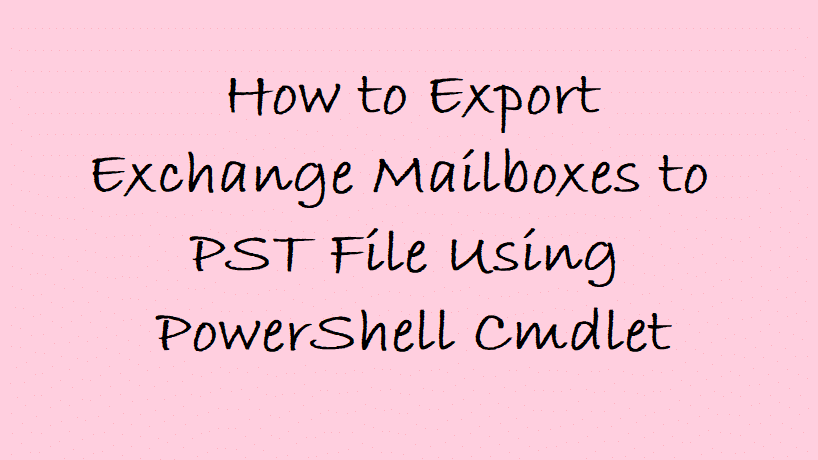How to Export Exchange Mailboxes to PST File Using PowerShell Cmdlet

TechsPlace | Data stored in the EDB mailbox must be very important to someone. In case, any file is lost, it can cause serious problem to the user. Thus, it is very important that the data of mailbox is backed up. No doubt, the Exchange server is used extensively, but there are a limited number of backup options enabled here. So, to overcome the backup related problem, it is recommended to export Exchange mailboxes to PST file. Not only data security, but there are other causes too such as:
- Repairing corrupt EDB mailboxes
- Migration of emails from one user account to another
- Accessing PST file in Outlook is much easier
- Henceforth, different solutions are discussed to migrate EDB files to PST.
#Method 1: Using ExMerge Utility
ExMerge is the inbuilt utility provided by Microsoft, which helps the user to archive Exchange mailbox to PST. A user has to follow the given set of instructions to achieve this conversion:
1. To start with, launch ExMerge utility on the local system and select the radio button corresponding to Extract or Import (Two Step Procedure). Then, click on Next
2. Then, select radio button corresponding to Step 1: Extract data from an Exchange Server mailbox. Then, click on Next
3. In the Data Selection Criteria window, switch to Import Procedure tab. Select the radio button of Archive data to target store, then hit on OK to continue with the procedure of exporting Exchange mailboxes to PST file
4. Then, go to the Message Details tab and fill up the details. Hit on OK
5. From the next screen, choose the mailboxes which are to be exported
6. Then, select the destination location to store the data in PST format
#Method 2: Using PowerShell Command
It must be very clearly noted that a user should have right to perform import and export operation. If a user does not have right to import or export the mailboxes, execute the following commands in PowerShell:
New-ManagementRoleAssignment –Role “Mailbox Import Export” –User sample
Here, the sample is the name of the account to whom rights are to be provided. Instead of awarding rights on a single account, mostly the rights are granted to the Admin group. So, if in the future, rights are to be assigned to any new account, then this account should be simply added to the Admin group. To achieve this, execute the following command:
New-ManagementRoleAssignment -Role “Mailbox Import Export” -SecurityGroup Exchange_AdminGroup
In this command, Exchange_AdminGroup is the name given to the Admin group. The same can be achieved using EAC (Exchange Admin Center). Once the rights are obtained, restart the Exchange Admin Center.
Procedure to Backup EDB Mailboxes to PST Outlook 2013:
Once all the rights have been granted, the steps to export Exchange mailboxes to PST are described here:
Manual 1:
Migrate all the mailboxes to a variable like:
$ VariableMailboxes= Get-Mailbox
In this command, VariableMailboxes refers to a variable. Then, migrate Exchange mailbox to PST using the following command:
$VariableMailboxes|%{$_|New-MailboxExportRequest -FilePath \\\\$($_.Alias111).pst}
Manual 2:
Another method is to use for each command instead of piping.
$ Mailboxes = Get-Mailbox
and then,
for each ($Mailbox){ New-MailboxExportRequest -Mailbox $Mailbox -FilePath “\\\\$($Mailbox.Alias111).pst” }
Restrict Exported Mailboxes Scope:
Additionally, the scope of the mailbox can also be limited using Get-Mailbox – Filter parameter. For instance,
Get-Mailbox -Filter {MemberOfGroup -ne $export1}
In this case, the filter parameter will forbid the mailbox stated in the parameter.
Shortcomings of the Workaround Approach
No doubt, the manual techniques to export Exchange mailboxes to PST format are simple, but they are not effective and do not produce desired results. Some of the limitations of the manual method are:
- If a user is using ExMerge to move mailboxes from the Exchange Server to PST format, there exists a file size limitation. It does not equip the user to export EDB file more than 2 GB.
- The corrupted EDB file cannot be exported using the workaround approach.
- Manual methods are lengthy and very time-consuming.
- If a user performs any step wrong, there are chances of data loss.
A Perfect Solution to Export Exchange Mailboxes to Outlook
All the drawbacks imposed by the manual solution can be conquered by using an automated tool like MailPro+ EDB to PST converter. According to the experts, it is the master solution to convert exchange files to PST. It is very easy to use this product to perform the conversion process. No change in the structure of the data has been noticed. By using this application, not even a single bit of data is lost.

Wrapping Up
Often, users tend to migrate from Microsoft Exchange to Outlook PST. But, they do not know how to perform that conversion in an effective way. Hence, the post deals with multiple manual methods. Moreover, a professional tool is also introduced to export Exchange mailboxes to PST file.





